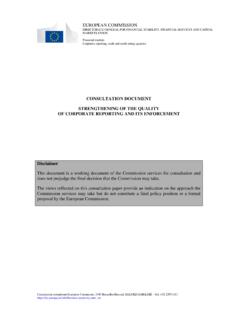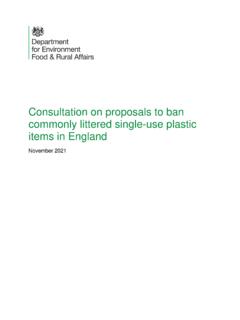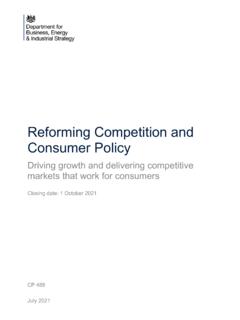Transcription of Public Consultation Report on Taxonomy extension options ...
1 1 Public Consultation Report on Taxonomy extension options linked to environmental objectives July 2021 2 Table of Contents 1. Introduction to the EU Platform on Sustainable Finance .. 3 2. Purpose of this Report .. 4 Important caveat .. 4 3. Why extend the Taxonomy ? .. 5 The present green Taxonomy .. 5 The binary classification problem .. 6 Feedback from outreach .. 7 The balance of arguments .. 8 4. Framework for extension .. 12 Conceptual framework .. 12 The dynamic Taxonomy .. 16 Taxonomy activities are not directly comparable to NACE activities .. 20 5. Significantly Harmful activities .. 21 Why extend the Taxonomy to SH activities.
2 21 Three performance levels .. 21 Activities with no technological possibility to transition away from significant harm .. 24 Transitions and Intermediate Performance levels .. 25 Implementation options .. 32 6. NSI activities .. 34 Why extend the Taxonomy to NSI activities? .. 34 Definition .. 38 How material are NSI activities? .. 39 options considered .. 40 Implementation .. 41 7. Further work .. 42 8. Interim Platform Recommendations .. 43 Annex 1. Outreach and Consultation .. 48 Annex 2. Concepts defined within the Taxonomy and associated Regulations .. 51 3 1. Introduction to the EU Platform on Sustainable Finance The EU Platform on Sustainable Finance is a permanent expert group of the European Commission, established under Article 20 of the Taxonomy Regulation, EU Regulation 2020/852.
3 It incorporates a balanced representation of sustainability experts from EU organisations, the financial industry, the corporate and Public sector, as well as academia and civil society. Its role is to advise the Commission on tasks and topics related to implementation and further development of the EU Taxonomy . As provided for in Article (a) of the Taxonomy Regulation, the European Commission gave the Platform for Sustainable Finance a mandate to work on a possible extension to the Taxonomy , to include activities significantly harmful to environmental sustainability and activities with no significant impact on environmental sustainability, and the Platform s Chair therefore established a subgroup dedicated to this task.
4 4 2. Purpose of this Report This Report examines the premises, issues and options for and against extending the EU Taxonomy beyond green to include significantly harmful (SH) activities and no significant impact (NSI) activities (both in relation to environmental sustainability) within the overall EU sustainable finance framework. This Report represents a work in progress and is published to gather feedback which will further inform the Platform as it continues to work on these topics, aiming to publish a Final Report later in the year. The findings in the Platform s Final Report will help inform the Commission s decisions as they respond to the requirement of Article (a) of the Taxonomy Regulation, EU Regulation 2020/852.
5 This Taxonomy Regulation Article requires the Commission to publish, by end December 2021, a Report describing the provisions necessary to extend the scope of the TR beyond environmentally sustainable economic activities. The Commission recommitted to this timing in the recent Renewed Strategy for Financing the Transition to a Sustainable The Platform has interpreted its brief to address environmental sustainability by taking into account the six environmental objectives of the Taxonomy Regulation (TR). Important caveat Whilst this Report summarizes interim observations and recommendations, it should be noted that these are not final, that all members of the Platform are not fully aligned in their views on one or other extension of the Taxonomy discussed herein, and that the topics covered by this Report are still subject to ongoing work by the Platform.
6 The feedback received in the Public Consultation on this Report will be an important input to this ongoing work. Following the analysis of responses to the Public Consultation , and taking account of further considerations by the Platform, final recommendations will be put forward later in 2021. 1 5 3. Why extend the Taxonomy ? The present green Taxonomy The EU Taxonomy (subsequently referred to as the Taxonomy ) is a classification system to identify economic activities that achieve performance levels making a substantial contribution (SC) to at least one of six environmental objectives2, whilst ensuring that the activity will do no significant harm (DNSH) to any of the other five objectives and also meet minimum safeguards (Article 3 of the TR).
7 Such activities with a level of performance meeting the relevant technical screening criteria (TSC) thresholds for SC and DNSH are referred to as Taxonomy -aligned or green . The purpose of the Taxonomy is to increase financial flows towards green activities and avoid green-washing by setting science/evidence-based criteria for different categories of performance. Activities considered most environmentally impactful and with most impact reduction potential, have been prioritised for the Taxonomy , and related TSCs defining SC and DNSH performance thresholds for each of those activities are established in Delegated Acts adopted by the Commission.
8 At the time of writing, only the first climate Delegated Act had been published, covering the objectives of climate change mitigation and climate change adaptation. Work to identify activities and TSCs for the remaining four objectives, carried out by the Technical Working Group (TWG) of the Platform, is on-going, as well as work proposing criteria for some further activities for the two climate change objectives. The Taxonomy , as described in the Action Plan for financing sustainable growth (2018), is the cornerstone of a larger framework for EU sustainable finance, involving several inter-linked regulations and actions on sustainable finance products, disclosures and reporting requirements, which reference the Taxonomy .
9 Other EU policy refers to the Taxonomy as a benchmark for identifying green financial products and environmentally sustainable activities. The ambition of the EU Taxonomy is to become the gold standard for green finance, not just in Europe, but also amongst international Taxonomy efforts. 2 The six environmental objectives covered by the Taxonomy are: climate change mitigation; climate change adaptation; the sustainable use and protection of water & marine resources, the transition to a circular economy, pollution prevention and control, the protection and restoration of biodiversity & ecosystems. 6 The binary classification problem In its recent Frequently Asked Questions document Q&A ( ), the Commission underlined that activities that are not green are not necessarily unsustainable.
10 The current design of the Taxonomy is often, however, misinterpreted as binary. As a result, activities unable to Report as green may be mistakenly considered by some users as environmentally unsustainable . In reality the Taxonomy is not binary, but rather only allows activities meeting high standards of environmental performance against objective criteria to be classified as green. For financial market participants and undertakings reporting against the Taxonomy , activities not classed as green can include a range of environmental performance levels, alongside activities not yet listed with technical screening criteria in Delegated Acts.


















